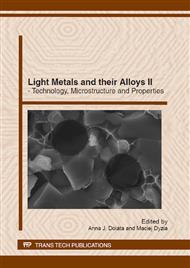p.89
p.101
p.109
p.115
p.123
p.131
p.137
p.145
p.151
Fractography and Structural Analysis of WE43 and Elektron 21 Magnesium Alloys with Unmodified and Modified Grain Size
Abstract:
Magnesium alloys, thanks to their low density, are characterized by very high specific strength and specific stiffness. Due to acceptable mechanical properties, these alloys are widely used in automotive and aerospace industries for the elements such as: gearbox and engine housings, steering wheel columns or wheels. The main problem of the most common magnesium alloys – such as AZ91 are their weak high temperature properties. This led to development of alloys containing rare earth elements. These alloys achieve their demanded mechanical properties after grain refinement with the zirconium. Because of a big responsibility of the elements made from Mg-RE alloys, it is important to investigate modification impact on properties of the magnesium alloys. The paper presents results of studies properties of the WE43 and Elektron 21 casting magnesium alloys, modified in three different ways – according to Magnesium-Elektron specification, 50% stronger modification and 100% stronger. For the comparison, unmodified alloys were also investigated. Investigations showed, that alloys modified according to MEL specification presents optimal set of structural and mechanical properties. Further increase of amount of modifiers doesn’t let to significant increase of mechanical properties. Fractographic investigations showed many non-metallic inclusions on the fractures surface, which are result of faulty smelting process.
Info:
Periodical:
Pages:
123-130
Citation:
Online since:
August 2012
Authors:
Price:
Сopyright:
© 2012 Trans Tech Publications Ltd. All Rights Reserved
Share:
Citation:


